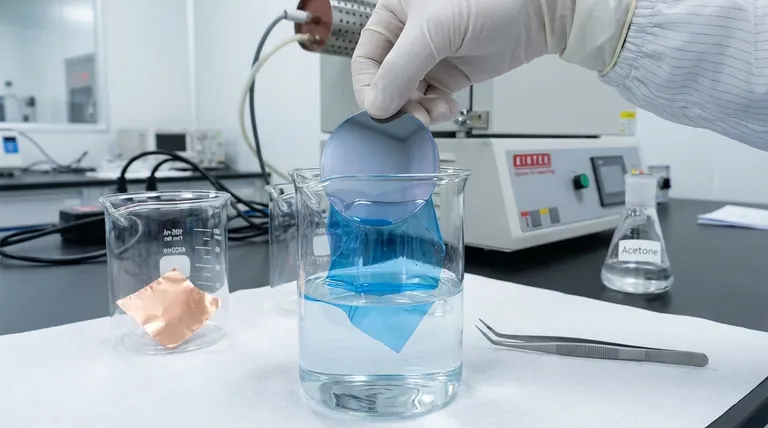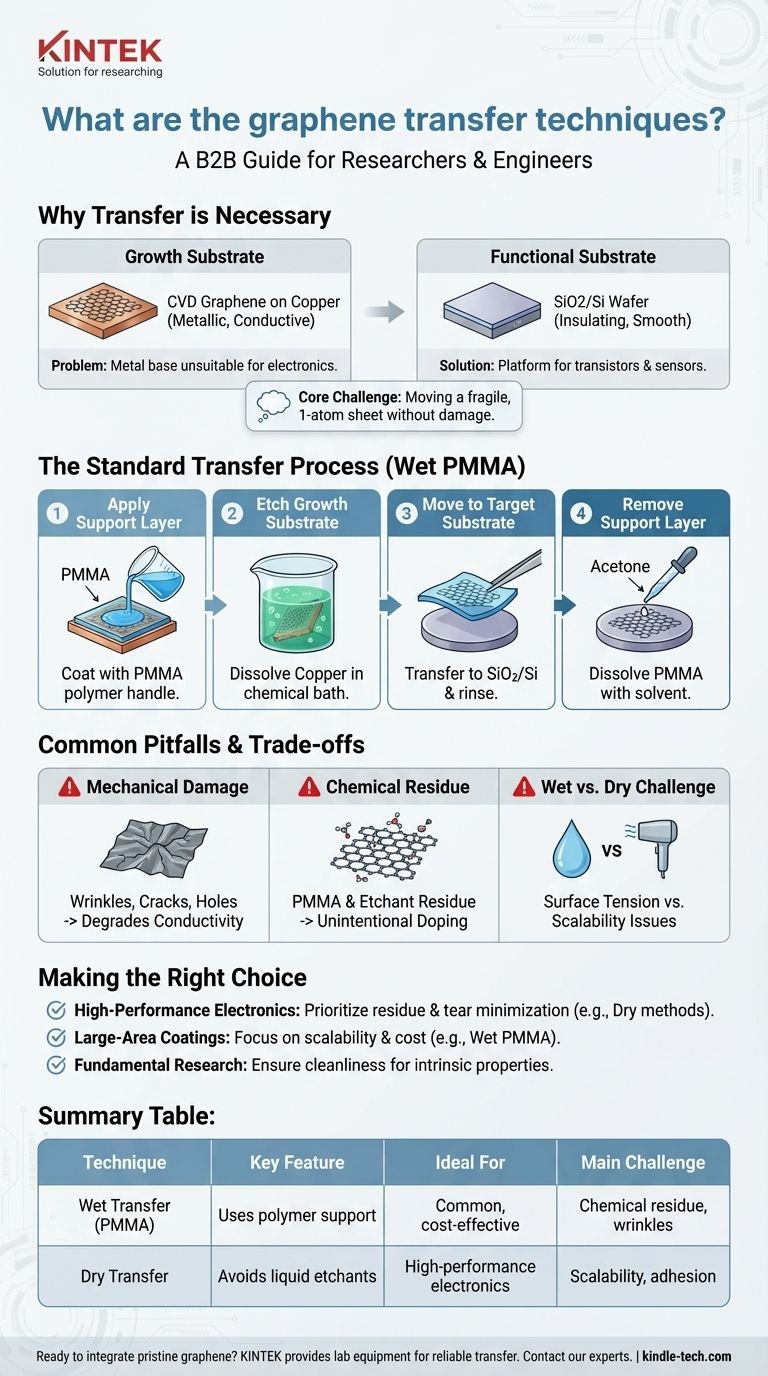가장 일반적인 방법은 폴리머 지지층(일반적으로 PMMA)을 사용하여 단일 원자 두께의 필름을 성장 기판에서 목표 기판으로 이동시키는 것입니다. 그래핀을 PMMA로 코팅한 후, 원래의 성장 기판을 화학적으로 식각하여 PMMA/그래핀 필름이 떠오르게 되며, 이 필름을 새 표면에 조심스럽게 배치한 다음 PMMA를 용해시킵니다.
그래핀 전사의 핵심 과제는 취약한 원자 한 층 두께의 시트를 긁힘, 찢어짐 또는 탁월한 특성을 저하시키는 화학적 오염 없이 한 표면에서 다른 표면으로 이동시키는 것입니다.
그래핀 전사가 필요한 이유
성장 기판의 문제점
그래핀은 종종 화학 기상 증착(CVD)과 같은 방법을 사용하여 합성되며, 이 과정에서 구리 포일과 같은 금속 촉매 위에서 얇은 막으로 성장합니다.
성장에는 탁월하지만, 이러한 금속 기판은 특히 절연체 또는 반도체 기반이 필요한 전자 분야에서 그래핀의 최종 응용 분야에는 적합하지 않습니다.
기능성 기판으로의 이동
트랜지스터, 센서 또는 기타 장치를 제작하려면 그래핀을 기능성 목표 기판으로 이동해야 합니다.
산화물 층(SiO2/Si)이 있는 실리콘 웨이퍼는 절연성이 있고 표면이 매우 매끄러우며 전체 반도체 산업의 표준 플랫폼이기 때문에 일반적인 선택입니다. 전사 과정은 그래핀 합성 및 실제 응용 사이의 중요한 연결 고리입니다.

표준 전사 과정의 구조
가장 확립된 기술은 폴리머 지지체를 사용하여 그래핀 필름을 지지하는 "습식 전사"입니다.
1단계: 지지층 적용
폴리머 용액, 가장 일반적으로 폴리(메틸 메타크릴레이트) 또는 PMMA를 원래 성장 기판 위에 있는 그래핀 필름 바로 위에 코팅합니다.
이 PMMA 층은 임시 핸들 및 기계적 지지체 역할을 하여 초박형 그래핀이 후속 단계에서 접히거나 찢어지거나 분해되는 것을 방지합니다.
2단계: 성장 기판 식각
전체 샘플(PMMA/그래핀/구리)을 화학 용액, 즉 식각액에 넣어 원래의 성장 기판을 선택적으로 용해시킵니다.
구리 기판의 경우 염화제이철 또는 과황산암모늄과 같은 식각액을 사용합니다. 이 과정은 PMMA/그래핀 필름을 액체 표면에 띄웁니다.
3단계: 목표 기판으로 이동
떠 있는 필름은 종종 목표 SiO2/Si 기판을 그 아래에 담그고 천천히 들어 올리는 방식으로 식각액에서 조심스럽게 "낚아챕니다".
그런 다음 필름을 탈이온수에 헹구어 잔류 식각액을 제거한 후 새 기판 위로 조심스럽게 덮습니다.
4단계: 지지층 제거
필름이 목표 기판 위에 단단히 위치하면 마지막 단계는 PMMA 지지층을 제거하는 것입니다.
이는 일반적으로 아세톤과 같은 용매로 PMMA를 용해시킨 다음 최종 헹굼을 통해 수행됩니다. 성공하면 새 기판 위에는 깨끗한 단일 층의 그래핀만 남게 됩니다.
일반적인 함정과 상충 관계
완벽한 전사가 이상적이지만, 현실에서는 최종 그래핀 필름의 품질에 영향을 미칠 수 있는 상당한 어려움이 따릅니다.
기계적 손상 문제
원자 두께의 시트를 다루는 것은 엄청나게 어렵습니다. 주름, 균열 및 구멍은 전사 과정에서 발생하는 일반적인 결함입니다.
이러한 불완전성은 그래핀의 연속적인 벌집 격자를 방해하여 전기 전도도와 기계적 강도를 저하시킵니다.
화학 잔류물 문제
공정에 사용된 화학 물질, 즉 PMMA와 식각액은 잔류물과 오염을 남길 수 있습니다.
미량의 폴리머나 금속 이온이라도 의도치 않게 그래핀에 "도핑"되어 전자 특성을 변경하고 장치 성능을 저해할 수 있습니다.
습식 대 건식 과제
설명된 표준 "습식" 전사 과정은 주름을 유발하고 신중한 건조가 필요한 액체의 표면 장력을 유발합니다.
이로 인해 대안적인 "건식" 전사 방법이 개발되었지만, 이러한 방법들은 확장성과 필름 접착력 측면에서 자체적인 상충 관계를 갖는 경우가 많습니다. 습식 PMMA 방법은 상대적인 단순성과 낮은 비용으로 인해 가장 일반적인 방법으로 남아 있습니다.
목표에 맞는 올바른 선택
전사 과정에서 허용 가능한 결함 수준은 의도된 응용 분야에 전적으로 달려 있습니다.
- 고성능 전자 장치에 중점을 둔 경우: 최우선 순위는 화학 잔류물과 기계적 찢김을 최소화하는 전사 과정이어야 합니다. 이러한 요소는 캐리어 이동도와 장치 신뢰성에 직접적인 영향을 미치기 때문입니다.
- 대면적 코팅 또는 복합재에 중점을 둔 경우: 확장성, 비용 및 넓은 영역에 걸쳐 필름 연속성을 유지하는 것이 완벽하게 깨끗하고 결함 없는 단일층을 달성하는 것보다 더 중요합니다.
- 기초 연구에 중점을 둔 경우: 전사의 청결도와 기판 선택은 실험 측정값이 공정으로 인한 인공물이 아닌 그래핀의 고유한 특성을 반영하도록 보장하는 데 가장 중요합니다.
궁극적으로 그래핀의 잠재력을 최대한 발휘하기 위해서는 그래핀의 성장을 마스터하는 것만큼 전사를 마스터하는 것이 중요합니다.
요약표:
| 기술 | 주요 특징 | 이상적인 용도 | 주요 과제 |
|---|---|---|---|
| 습식 전사 (PMMA) | 폴리머 지지층 사용 | 일반적인 방법, 비용 효율적 | 화학 잔류물, 주름 |
| 건식 전사 | 액체 식각액 방지 | 고성능 전자 장치 | 확장성, 접착력 |
완벽한 그래핀을 장치에 통합할 준비가 되셨습니까? 올바른 전사 기술은 성능에 매우 중요합니다. KINTEK은 연구 개발 실험실에 안정적인 그래핀 전사에 필요한 실험 장비 및 소모품을 제공하는 데 특화되어 있습니다. 귀하의 특정 응용 분야 요구 사항을 논의하고 고품질 결과를 보장하는 방법에 대해 논의하려면 지금 전문가에게 문의하십시오.
시각적 가이드

관련 제품
- 고객 맞춤형 다용도 CVD 튜브로 화학 기상 증착 챔버 시스템 장비
- 효율적인 샘플 혼합 및 균질화를 위한 실험실 디스크 회전 믹서
- 소형 부품 생산용 상온 등압 성형기 CIP 400Mpa
- PTFE 용기용 맞춤형 PTFE 테플론 부품 제조업체
- 흑연 진공 연속 흑연화로



















